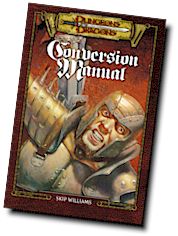Feb 9th |
Next Game Calendar
Game Recaps:
 |
Born Again?

3rd Edition Conversion



From the Library of Arcane Documents and Tombs
Characters From Earlier Editions To use characters from any earlier edition of the Dungeons & Dragons or Advanced Dungeons & Dragons game with the 3rd Edition D&D game, just follow the steps outlined below. You'll need a copy of the 3rd Edition Player's Handbook and a fresh 3rd Edition D&D character sheet or clean sheet of scratch paper. You'll find a photocopiable character sheet in the new PH. Later in this book you will see sample character sheets that illustrate how characters created under the 2nd Edition AD&D rules change when converted to the new rules. Level and Experience For single-classed characters, record the character's current level. You will need to adjust the character's experience point total to match the 3rd Edition D&D experience system. Characters with more than one class require special handling. · Adjusting Experience Points: All characters in the 3rd Edition D&D game use the same experience table. The table is constructed differently from the class experience tables in earlier versions of the game, which makes it necessary to adjust the character's experience point total. The easiest way to make the adjustment is simply to set the total at some point between the minimum for the character's current level and the minimum for the next level (we recommend halfway to the next level or the minimum for the current level). If you prefer a more accurate conversion of the character's experience total, see the Character Troubleshooting section. · Adjusting Dual- and Multiclassed Characters: The rules for handling a character with more than one class in the 3rd Edition D&D game are considerably different than in previous editions of the game (see sidebar). Follow these steps to calculate a dual- or multiclassed character's level: 1. Find the highest level the character has reached in any class. For example, Escolrande is an 8th-level fighter/9th-level wizard/9th-level thief. His highest level is 9. 2. Divide each level the character has achieved in any other class by three and round down. If the result rounds down to 0, record a 1 instead. For example, Escolrande's remaining levels are 8 and 9; 8 divided by 3 = 2.67, which rounds down to 2, and 9 divided by 3 = 3. 3. Add the numbers you got in step 2 to the number you got in step 1. This equals the character's level in the 3rd Edition D&D game. In Escolrande's case, 9+2+3=14. 4. You can divide up the levels among classes any way you see fit. For example, Escolrande could become a 9th-level wizard/4th-level rogue/1st-level fighter, or an 8th-level wizard/3rd-level rogue/3rd-level fighter, or any other combination of wizard, rogue, and fighter levels that adds up to 14. Ability Scores Record the character's existing ability scores. In some cases, you'll need to adjust your character's ability scores. Exceptional Strength: The exceptional Strength rule is no longer part of the game. If your character has an exceptional Strength score, convert it to a regular Strength score as shown in the table below. Level-Based Improvement: For every four levels the character has attained, add one point to any one ability score. Don't worry about racial maximums, they no longer exist. When you've finished adjusting and recording your character's ability scores, turn to Table 2-1 in the Player's Handbook. This table gives the bonus or penalty (now called an ability modifier) for any ability score. Ability Tips: Any ability score of 12 or more will give your character a bonus for something. Likewise, an ability score of 9 or less brings a penalty. Think twice about your character's Intelligence score, because it governs how many skills your character can learn and a high Intelligence score is much more useful for wizards than it used to be. Dexterity and Constitution remain important for all characters. Wisdom remains important for priest (now cleric) characters and now has a much greater impact on every character's saving throws and on many skills. A high Charisma score is important for bards, paladins, and clerics. What's New About Ability Scores? The game uses the same abilities (Strength, Dexterity, Constitution, Intelligence, and Charisma) it has always used. Significant changes include: Bonuses and Penalties from Ability Scores: All six abilities use the same table (Table 2-1 in the PH) to determine the bonus or penalty associated with each score. In the 3rd Edition D&D game, the bonus or penalty is called the ability modifier. Ability Checks: To make an ability check, you roll 1d20 and add your character's ability modifier. To succeed, an ability check result has to equal or exceed the task's Difficulty Class (DC), which starts at 10 and goes up. Ability Maximums and Minimums: There are no longer any ability score maximums or minimums for races. Ability Requirements: It is no longer necessary to meet any ability requirements to qualify for a race or class. Exceptional Strength: This no longer exists. Existing characters can convert their exceptional Strength scores into regular Strength scores above 18. Experience Bonuses: Characters no longer receive bonus experience for high ability scores. Level-based Ability Adjustments: For every four levels a character achieves, one ability score of the player's choice improves by one point. New Names for Some Old Terms The following terms have new names in the new edition. The new names often reflect changes to the way the game works or simply better reflect what the terms represent: |
||||||||||||||||||||||||||||||||||||||||||
Helpful sidebars appear throughout the text to remind you of what has changed in the rules. |
 |
Or you can download a PDF of the book right here. |
|